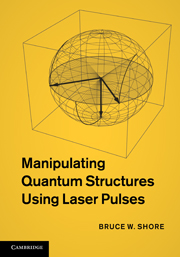Book contents
- Frontmatter
- Contents
- Preface
- Acknowledgments
- 1 Introduction
- 2 Atoms as structured particles
- 3 Radiation
- 4 The laser–atom interaction
- 5 Picturing quantum structure and changes
- 6 Incoherence: Rate equations
- 7 Coherence: The Schrödinger equation
- 8 Two-state coherent excitation
- 9 Weak pulse: Perturbation theory
- 10 The vector model
- 11 Sequential pulses
- 12 Degeneracy
- 13 Three states
- 14 Raman processes
- 15 Multilevel excitation
- 16 Averages and the statistical matrix (density matrix)
- 17 Systems with parts
- 18 Preparing superpositions
- 19 Measuring superpositions
- 20 Overall phase; interferometry and cyclic dynamics
- 21 Atoms affecting fields
- 22 Atoms in cavities
- 23 Control and optimization
- Appendix A Angular momentum
- Appendix B The multipole interaction
- Appendix C Classical radiation
- Appendix D Quantized radiation
- Appendix E Adiabatic states
- Appendix F Dark states; the Morris–Shore transformation
- Appendix G Near-periodic excitation; Floquet theory
- Appendix H Transitions; spectroscopic parameters
- References
- Index
4 - The laser–atom interaction
Published online by Cambridge University Press: 07 October 2011
- Frontmatter
- Contents
- Preface
- Acknowledgments
- 1 Introduction
- 2 Atoms as structured particles
- 3 Radiation
- 4 The laser–atom interaction
- 5 Picturing quantum structure and changes
- 6 Incoherence: Rate equations
- 7 Coherence: The Schrödinger equation
- 8 Two-state coherent excitation
- 9 Weak pulse: Perturbation theory
- 10 The vector model
- 11 Sequential pulses
- 12 Degeneracy
- 13 Three states
- 14 Raman processes
- 15 Multilevel excitation
- 16 Averages and the statistical matrix (density matrix)
- 17 Systems with parts
- 18 Preparing superpositions
- 19 Measuring superpositions
- 20 Overall phase; interferometry and cyclic dynamics
- 21 Atoms affecting fields
- 22 Atoms in cavities
- 23 Control and optimization
- Appendix A Angular momentum
- Appendix B The multipole interaction
- Appendix C Classical radiation
- Appendix D Quantized radiation
- Appendix E Adiabatic states
- Appendix F Dark states; the Morris–Shore transformation
- Appendix G Near-periodic excitation; Floquet theory
- Appendix H Transitions; spectroscopic parameters
- References
- Index
Summary
As light passes an atom, it exerts forces on the charges, electrons, and nuclei that alter the atomic structure. These may be slight distortions (perturbations) of the electron cloud or they may be more severe, as described in subsequent sections of this monograph. We wish to determine those changes, given the radiation field, or to devise a radiation field that will produce specified changes.
The changes to the atomic structure also affect the radiation that subsequently passes the atom. To describe those effects we must consider wave equations for radiation in the presence of altered atomic structure. More generally we must find self-consistent equations for the atoms and the field together, as discussed in Chaps. 21 and 22. Here we consider mathematical descriptions of the influence of coherent radiation on individual atoms, molecules, or other single quantum systems.
Individual atoms
Traditional sources of emission and absorption spectra, though revealing energy states of the constituent atoms and molecules, are macroscopic samples. One observes averaged characteristics of many individual particles, see Chap. 16. Quantum theory offers the basic formalism for dealing with individual atoms exposed to controlled radiation fields. Several experimental techniques provide acceptable approximations to this ideal. The following paragraphs note some of these examples.
Vapors
Neutral atoms or molecules in a vapor move freely along straight-line paths, interrupted by brief collisions that redirect the two collision partners. When the kinetic energies of the two partners are small, there can be no transfer of kinetic energy into internal energy of either particle – the collision is elastic.
- Type
- Chapter
- Information
- Manipulating Quantum Structures Using Laser Pulses , pp. 44 - 56Publisher: Cambridge University PressPrint publication year: 2011

